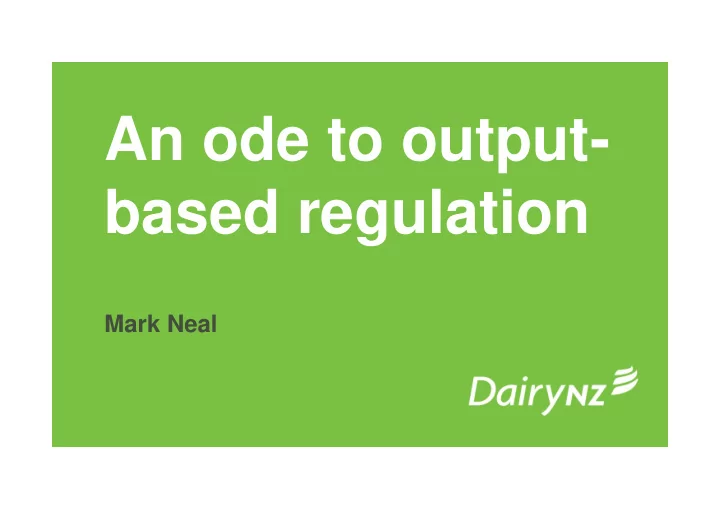

An ode to output- based regulation Mark Neal
Let’s fix the problem! • The Government needs to set "appropriate limits on fertiliser application and stock levels" – Labour Party water and environment spokesman David Parker June 28, 2016. Stuff.co.nz
Simple Production function N fert. Cows MS Profit Env. N leach Damage
Stocking rate farmlet trial A E Stocking rate, c/ha 2.2 4.3 N Fertiliser, kg N/ha Equal Production, kg MS/ha ~900 ~1140 Profit, $/ha ~Equal N leaching, kg N/ha 50 ? Roche et al., 2016
Stocking rate farmlet trial A E Stocking rate, c/ha 2.2 4.3 N Fertiliser, kg N/ha Equal Production, kg MS/ha ~900 ~1140 Profit, $/ha ~Equal N leaching, kg N/ha 50 20 Roche et al., 2016
Likelihood of N loss Faecal/ Autumn Urinary N Fertiliser N Romera and Doole, 2015
Actual Production function Other “Trade” Land Profit interventions Farm Systems Mitigations Labour Bacteria Groundwater Pasture Capital N Fertiliser Cows Sediment Waterways MS MS Irrigation Supplement P Edge of Field Non-regulatory Labour GHG mitigation approaches
Efficiency • Resource availability • Managerial ability – Graze at 2 vs 3 leaf (Chapman et al.) – No feed wedge, fast rotation vs slow rotation (Bryant et al.) • Future – New plant breeds
Standard mitigation approach • System adjustment (not radical change) • Apply GMP’s (cheapest gains) • Keeping the cows diet and MS/cow constant: – Reduce N fert – Reduces feed available (x%) – Reduce stocking rate pro rata (x%) • Infrastructure comes next
Abatement curves Percentage
Abatement curves Percentage Absolute
Abatement curves $40/kg N Percentage Absolute $100/kg N $20/kg N
N mitigation vs P mitigation: FSM Reduction in P loss Reduction in N loss
N mitigation vs GHG mitigation: Diet CH4 Urinary N Gregorini et al. 2016
Trade – an opportunity? • Heterogeneity -> benefits from trade – Between farms of one class – Between classes of farms • Doole (2012), 30% reduction N – Differentiated (Trade); Cheapest – Uniform %; Cost +40% – Reduce to threshold; Cost +300%
Coase and property rights • As long as transactions costs are not excessive: • Whether property rights are assigned to farmers or environment doesn’t effect final abatement result.
Tax or tradeable permits? • If set at the appropriate levels: • Can have exactly the same abatement result
Barns Lower N leaching Journeaux and Newman, 2015
Barns Journeaux and Newman, 2015
Artificial wetlands
Nitrate Catcher
Riparian planting
Aquifer recharge
Attenuation Distance, Time lag, Denitrification potential Farm N loss Impact
Sustainable milk plans • Upper Waikato; 700 farms • Current – 5% for N, 12% for P • Expected – 8% for N, 21% for P
Good Management Practice • Industry agreed (in principle) • How is it quantified and modelled? • MGM: Don’t have to do GMP – Just meet the number – “… the GMP Loss Rate number is inseparable from the GMPs ...is only able to be achieved ...”
N restrictions • N in winter: Eliminate – Low response (but high value) – High loss rate?
Likelihood of N loss Faecal/ Autumn Urinary N Fertiliser N Romera and Doole, 2015
N restrictions • N in winter: Eliminate – Low response (but high value) – High loss rate? • N amounts overall: Cap monthly – Diminishing returns? – Substitute for supplement?
Irrigation efficiency as mitigation
Conclusions • Policy aim – Meeting catchment objectives at least cost • Input restrictions don’t do this! • Tradable permits are possible, but: – Initial allocation? – Who bears uncertainty? • Output-based regulation, with some flexibility – An acceptable middle ground?
Recommend
More recommend